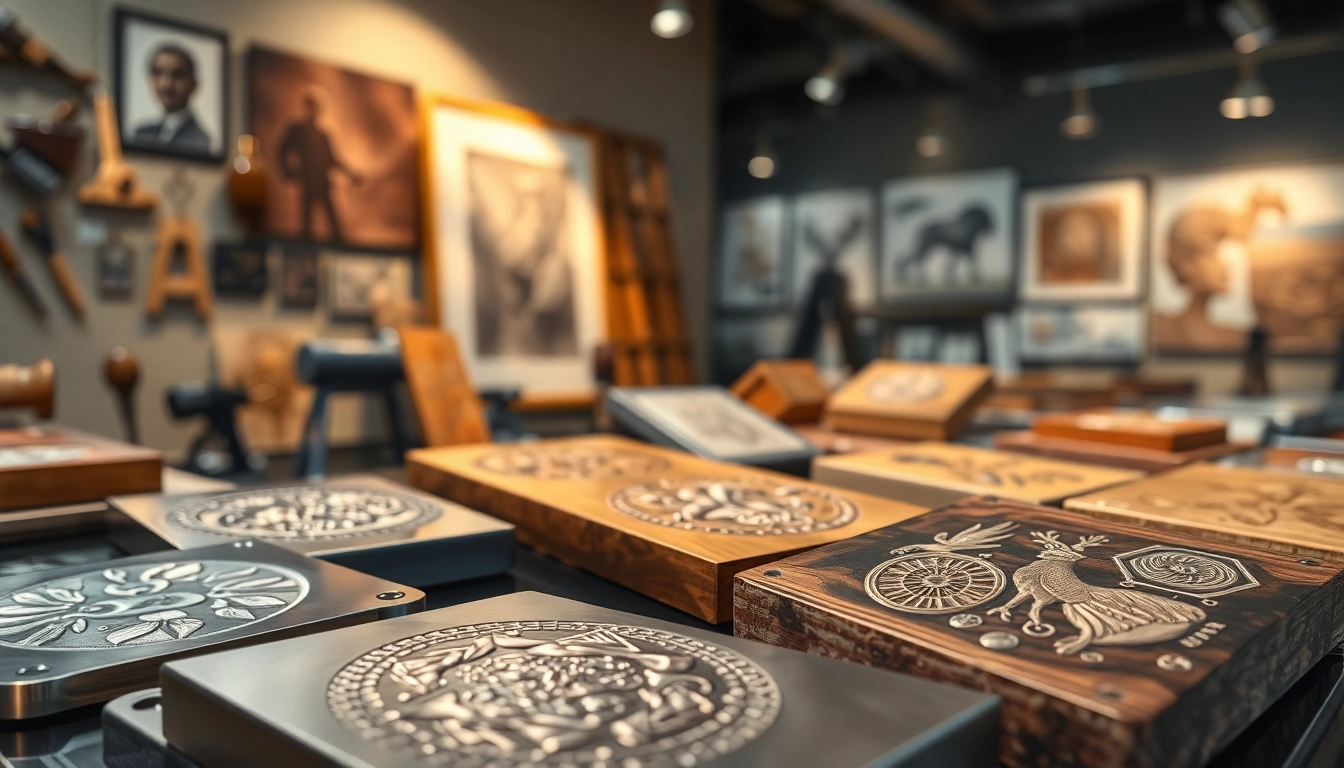Understanding Engravings: Definition and History
What are Engravings?
Engravings are the result of a meticulous process involving the incising of designs onto hard, flat surfaces. These designs are created through the action of cutting grooves into the material, which may be metal, wood, or even glass. The main purpose of engravings extends beyond mere aesthetics; it also encompasses functionalities such as printing and identification. Art forms derived from engravings can be found in various cultures around the globe, showcasing the versatility of this ancient craft. Additionally, the term engravings itself is often used to refer to prints made from engraved plates, amplifying their importance in art history and printing technologies.
The Evolution of Engraving Techniques
The journey of engraving dates back thousands of years, originating as a practical method for marking weapons, pottery, and tools. In early civilizations, such as those in Egypt and Mesopotamia, engravings were primarily functional. As arts developed during the Renaissance, engraving transitioned into a celebrated art form. Techniques evolved, with artists adopting various methods, including burin (a pointed tool used for cutting), woodcuts, and later, lithography and etching. Each advancement opened up new dimensions for creativity, enabling more intricate and detailed works that could be replicated for wider audiences.
Historical Significance of Engravings in Art
Engravings hold a pivotal position in the history of art, influencing both artists and the broader culture. They served as a key medium for disseminating ideas and aesthetics. Notably, during the Renaissance, artists like Albrecht Dürer and Rembrandt used engravings to explore light, shadow, and texture, transforming them into significant artworks. They facilitated a connection between art and the masses, enabling the reproduction of images and thereby enhancing the reach of artistic concepts. Through the ages, engravings have informed styles, bridged cultural divides, and laid the groundwork for modern printmaking.
Types of Engravings: Exploring the Varieties
Line Engraving and Its Applications
Line engraving is arguably one of the oldest forms of engraving. It involves making incisions using a burin, allowing for precise and detailed lines. This technique is primarily used in creating prints but is also utilized in fine art and illustrations. The robust line work achieved through this method allows artists to create depth and dimension in their designs. Its applications extend beyond traditional art; for instance, line engravings are widely used in jewelry making for intricate detailing.
Wood Engraving Techniques
Wood engraving is a relief printing technique that utilizes the end grain of wood blocks. This method allows for finer details than traditional woodcuts, which are cut from the plank surface. As the artist carves out areas of the block, the remaining wood serves as the printing surface. This technique became prominent in the 19th century, particularly for book illustrations, as it provided fine lines and details that were essential for publishing. The durability of wood engravings has also made them popular for commercial printing and decorative arts.
Modern Laser Engravings
With advancements in technology, laser engraving has emerged as a leading technique in contemporary engravings. This method utilizes focused laser beams to engrave designs onto various materials, including metals, glass, leather, and plastics. The precision of laser engraving allows for extraordinary detail and customization, making it ideal for both industrial applications and personalized gifts. As this technology continues to evolve, it offers exciting possibilities for artists and manufacturers, combining traditional artistry with modern efficiency.
Creating Visual Masterpieces: The Engraving Process
Tools Required for Engravings
The tools utilized in engraving vary depending on the technique being employed. For traditional methods, a range of burins and gravers are essential for incising designs. For wood engravings, specific tools are required to ensure precision in carving. In contrast, laser engraving demands sophisticated equipment that includes computers for design input and laser cutters for execution. Understanding these tools and their specific uses is essential for anyone looking to delve into the world of engravings, as each tool can dramatically impact the final outcome.
Step-by-Step Guide to Engraving
- Choose Your Material: Select a suitable surface based on the engraving method, such as metal for burin engraving or wood for woodcuts.
- Create a Design: Draft your design on paper and transfer it to the engraving material using carbon paper or a computer software to laser engrave.
- Prepare Your Tools: Ensure all tools are clean and sharp to avoid mistakes during the engraving process.
- Engrave Step-by-Step: Begin engraving, maintaining focus and steady hand movements. Work in sections to maintain control.
- Finish Your Piece: After completing the engraving, clean up any debris and apply finishes, if necessary, to enhance the material’s appearance.
Common Mistakes to Avoid in Engraving
Starting the engraving process without proper planning can lead to errors. One of the most common mistakes is not selecting the right tools for the job, which can result in uneven lines or damage to the material. Additionally, rushing through the design transfer process can cause misalignment, ruining the final product. Practicing patience, paying attention to detail, and performing test engravings on scrap material before creating the final piece can help avoid these pitfalls.
Engravings in Different Industries: Applications
Custom Engravings in Personal Gifts
Engravings play a significant role in providing personalization to gifts. Whether it’s a monogram on a piece of jewelry, a special date on a watch, or a heartfelt message on glassware, custom engravings elevate the sentiment of gifts. This trend has become increasingly popular for weddings, anniversaries, and other special occasions, as it allows for unique and meaningful tokens of affection. Moreover, the rise of online personalization platforms has made custom engravings more accessible to a broader audience, fueling this market segment.
Engravings in Industrial Applications
In the industrial sector, engravings are pivotal for creating identification markers, serialization on products, and branding purposes. They ensure that logos or information remain durable and visible over time. Techniques like laser engraving are favored in industries for their precision and ability to handle large-scale production. Moreover, engravings contribute to safety measures, such as warning labels on machinery and equipment, reinforcing the importance of clear communication in occupational settings.
Artistic Uses of Engravings in Modern Design
In the realm of contemporary design, engravings have transformed artistic expression. Designers utilize engravings to add textural elements to fashion, home decor, and even furniture design. The juxtaposition of engraved patterns against various materials can create captivating visual effects that enhance aesthetic appeal. Moreover, the rise of mixed media art has led to innovative uses of engravings, combining traditional techniques with modern themes and mediums, paving the way for new artistic movements.
Showcasing Engravings: Display and Preservation
Best Practices for Displaying Engravings
To showcase engravings effectively, it is crucial to consider the lighting and framing of the pieces. Natural light can enhance the details but may also fade materials over time, so using UV-protective glass in frames is advisable. Display options also include shadow boxes for three-dimensional engravings or wall mounts for larger artworks. Positioning the pieces at eye level ensures that viewers can appreciate the intricacies of the work.
Maintaining the Quality of Engravings
Maintenance is vital for preserving the integrity of engravings. Regular dusting with soft, non-abrasive cloths can prevent buildup that may damage the surface. For metal engravings, applying a thin layer of wax can provide additional protection against tarnishing. Additionally, ensuring that the environment where the engravings are displayed is climate-controlled can combat issues like warping or cracking due to humidity fluctuations.
Collecting and Appraising Engravings
As with any collectible art form, understanding the value of engravings is essential for collectors. Factors influencing value include the artist, the technique employed, and the artwork’s historical context. Appraisers often consider the condition and rarity of the piece when determining its worth. Collectors should strive to keep documentation of provenance, as this can enhance the value and interest in the engravings they possess. Attending galleries and auctions can provide insights into current market trends and help collectors build a well-rounded collection.



